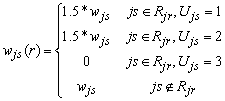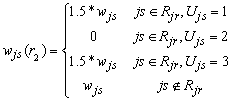- Surveys & Programs
- Data & Tools
- Fast Facts
- News & Events
- Publications & Products
- About Us
Table of Contents | Search Technical Documentation | References
NAEP Technical DocumentationComputing School-Level Replicate Weights
The replicate school base weights wjs(r), r = 1, ., R, were computed as follows:

where
-
wjs is the school base weight for school s in jurisdiction j;
-
Rjr is the set of schools within the r-th replicate stratum for jurisdiction j; and
-
Ujs is the variance unit (1 or 2) for school s in jurisdiction j.
Each triplet replicate stratum Rjr also has a paired replicate stratum r2. The replicate weights assigned to schools in Rjr are as follows:


For example, consider a state with 111 noncertainty schools in which the first 54 final replicate strata contain two schools each (doublets) and replicate stratum 55 contains three schools (triplet). Replicate stratum 55 is paired with replicate stratum 23 (i.e., r2 = 23).
In the first replicate stratum, for the first school
- the variance unit = 1;
- the replicate weight for the first replicate stratum = 2 times the school base weight; and
- the replicate weight for all other replicate strata = the school base weight.
In the first replicate stratum, for the second school
- the variance unit = 2;
- the replicate weight for the first replicate stratum = 0; and
- the replicate weight for all other replicate strata = the school base weight.
In the 55th replicate stratum, for the first school
- the variance unit = 1;
- the replicate weight for the 55th replicate stratum = 1.5 times the school base weight;
- the replicate weight for the 23rd replicate stratum = 1.5 times the school base weight; and
- the replicate weight for all other replicate strata = the school base weight.
In the 55th replicate stratum, for the second school
- the variance unit = 2;
- the replicate weight for the 55th replicate stratum = 1.5 times the school base weight;
- the replicate weight for the 23rd replicate stratum = 0; and
- the replicate weight for all other replicate strata = the school base weight.
In the 55th replicate stratum, for the third school
- the variance unit = 3;
- the replicate weight for the 55th replicate stratum = 0;
- the replicate weight for the 23rd replicate stratum = 1.5 times the school base weight; and
- the replicate weight for all other replicate strata = the school base weight.
In primary strata with fewer than 62 replicate strata, the replicate weights for the “unused” replicate strata (the remaining ones up to 62) for these schools were set equal to the school base weight (so that those replicates contribute zero to any replicate sum of squares).
Trimmed replicate school base weights were computed by multiplying each replicate school base weight wjs(r) by the trimming (of school base weights) factor TRIMjs.
Separate school nonresponse adjustment factors SNRADJjs(r) were calculated for each set of replicates. Nonresponse-adjusted replicate school base weights were computed by multiplying each trimmed replicate school base weight by the school nonresponse adjustment for that replicate. Thus, the school nonresponse factors are replicated, and the resulting school nonresponse adjusted replicate weights include a component of variance due to the school nonresponse factors.
Last updated 06 November 2008 (RF)